|
Aircraft Wrecks in the
Mountains and Deserts of the American West
PA-28
6/3/2001
On the
evening of June 3, 2001 twenty-four year old Daniel Katz went missing on a local
flight from Perris Valley Airport in Riverside County to Brackett Field in Los
Angeles County. The weather at the time included a deepening marine layer of
stratus clouds common in Southern California at that time of year. The last
known position of the Piper PA-28-181 Archer N8253W flown by Mr. Katz, the sole
occupant of the plane was a radar contact over Lytle Creek very near the east
end of the San Gabriel Mountains.
Despite an
extensive search effort lasting for several months no trace of N8253W was found.
Through the intervening years intermittent air and ground searches were
conducted. It was not until September 21, 2008 that a San Bernardino County
Sheriff’s helicopter crewman, on a routine patrol flight, spotted the wreckage
of a small plane at 5,700’ MSL on the north slope of a ridge east of Cucamonga
Peak. A mountain rescue team accompanied by the county coroner was flown by
helicopter to the ridge top some 300’ above the crash site. The rescue team
confirmed it was indeed the missing Piper Archer, and some remains of the pilot
were recovered.
How could
this relatively intact aircraft remain missing for so long a time? The
geography was one factor, the low visibility tan color of the aircraft was
another, and the fact that no ELT signal was received following the crash. Two
other aircraft were missing four years each in this same general area in the
1950’s. Both of these planes were eventually found by hikers going overland off
the trail. It is interesting that N8253W and Steve Fossett’s plane were found
within the same week. In the Fossett case it was hiker off the trail that made
the discovery. Finally, for two families there is closure, just before the snows
of winter would once again hide the aircraft and their pilots.
It was a
privilege for myself and several interested friends to observe the wreckage
recovery effort on October 3, 2008. Special thanks to Aircraft Recovery Service,
Western Helicopters, and Mr. George Peterson. I was impressed by the highly
organized, professional manner in which this difficult mission was accomplished.
Al of the wreckage was transported to a secure facility where NTSB investigators
will examine every aspect of the Piper Archer. When their work is completed a
public report will issued sometime in 2009.
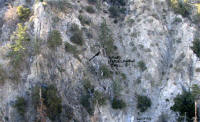
The crash site of
Piper Archer N8253W as seen on 10/3/08 above the Middle Fork of the Lytle
Creek in the San Gabriel Mountains. (G. P. Macha)
|
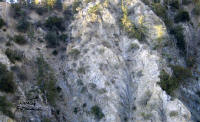
View of Piper Archer
main impact area at 5,700'MSL. |
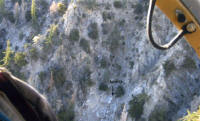
Wing of N8253W below
main impact in very steep ravine. (G. P. Macha)
|
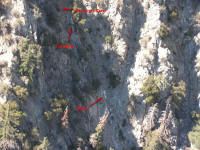
Dramatic view of the
Piper Archer crash site with the wreck recovery crew climbing down to
start their work. ( Ryan Gilmore photo)
|
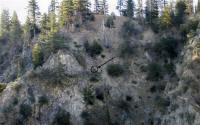
Member or wreck
recovery team en route to main impact on 10/3/08. (G. P. Macha)
|
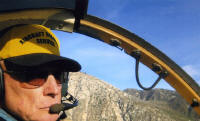
Western Helicopter
Company pilot, the legendary Pete Gillies en route to main impact on
10/3/08. (G. P. Macha)
|
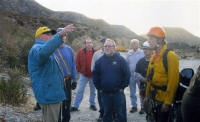
Helicopter pilot Pete
Gillies briefs the recovery team prior to flying the three men to the ridge
top above the crash site. (G. P. Macha) |
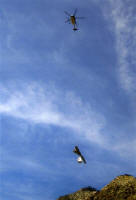
Using a "long line"
Pete Gillies brings the wing of N8253W. (G. P. Macha)
|
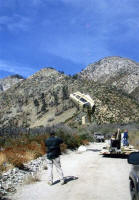
The intact cabin was
cut away from the aft fuselage and tail to facilitate recovery by the MD
500D helicopter.
(G. P. Macha)
|
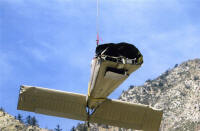
The tail assembly of
long missing Piper Archer N8253W arrives after a two minute "long line"
flight from the crash site. (G. P. Macha) |
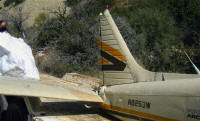
Another view of N8253W
recovered empenage and tail. (G. P. Macha)
|
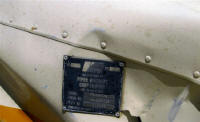
Piper data plate
located on the left side of the empenage next to the horizontal stabilizer.
(G. P. Macha)
|
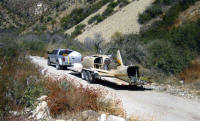
When all of the
aircraft was recovered the wreckage was transported to a secure facility
where the NTSB will examine the structure, engine, and all instrumentation
prior to issuing their findings in six to twelve months.
(G. P. Macha)
|
|
|